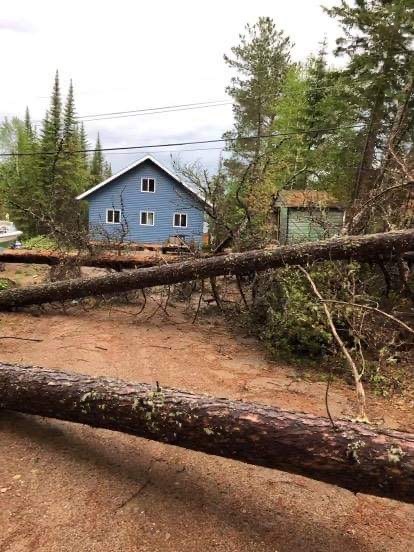THUNDER BAY — "It was absolutely wild," Alicia Piccinin said.
The Trout Lake resident was recalling the sudden and violent storm that struck an area encompassing Dog Lake, Hawkeye Lake, One Island Lake, Trout Lake and several lakes in Jacques Township north of Thunder Bay last Friday evening.
Piccinin says the storm developed within minutes.
"It was a beautiful, hot sunny day, and then all of a sudden everything went very green and very dark. We had this insane amount of wind and heavy, heavy rain and then came the hail."
The brief storm uprooted large numbers of trees, tossed boats around, and snapped 20 Hydro One utility poles before it was over.
It included wind gusts of 110 km/h.
Meteorologist David Sills says the evidence he has seen points to a combination of a classic downburst and a gustnado.
A gustnado is a swirling wind that can form on the leading edge of a severe thunderstorm.
The name derives from "gust front of a tornado," but it is not the same as a tornado.
Sills is the executive director of the Northern Tornadoes Project at Western University in London, Ont.
He said he and his team base their conclusions about what happened on June 4 on their examination of video, satellite and radar images and still photos.
Two pieces of video taken by residents at Dog Lake were particularly instructive.
Sills said the first showed "really strong wind associated with that thunderstorm – what we call a downburst. That's air that's cooled by rain. It falls down and spreads out as it reaches the ground and can cause damage to trees and buildings, sometimes on par with a weak tornado."
Other video revealed "something called a gustnado – or two – along the leading edge of that downburst. That's what you see that looks like a waterspout."
Sills explained that bits of rotation can develop along the leading edge of strong wind coming ahead of a thunderstorm.
"Some of that rotation gets intensified to the point where it's actually starting to pick up water and cause rotation," he said, but added "there is little connection to cloud base that we could see which would make it a tornado, so that's why this is called a gustnado."
According to Piccinin, the storm lasted perhaps 10 to 15 minutes, "but the damage that was done in that 10 to 15 minutes was unbelievable."
She described 80-foot trees completely uprooted, trees on buildings and vehicles, and power lines ripped from homes and camps.
At Wartman Lake, a sauna was overturned.
"It was unbelievable. It was very movie-like, not something you'd think was really going to happen," Piccinin said.
